Insight into Self and Society: Essay on Self in Modern Society
VerifiedAdded on 2023/06/13
|16
|4331
|139
AI Summary
This essay provides insight into the self and society, exploring the different types of self, behaviours, and psychological aspects. It discusses the social identity theory, psychosocial development theory, and James Marcia's theory about identity.
Contribute Materials
Your contribution can guide someone’s learning journey. Share your
documents today.
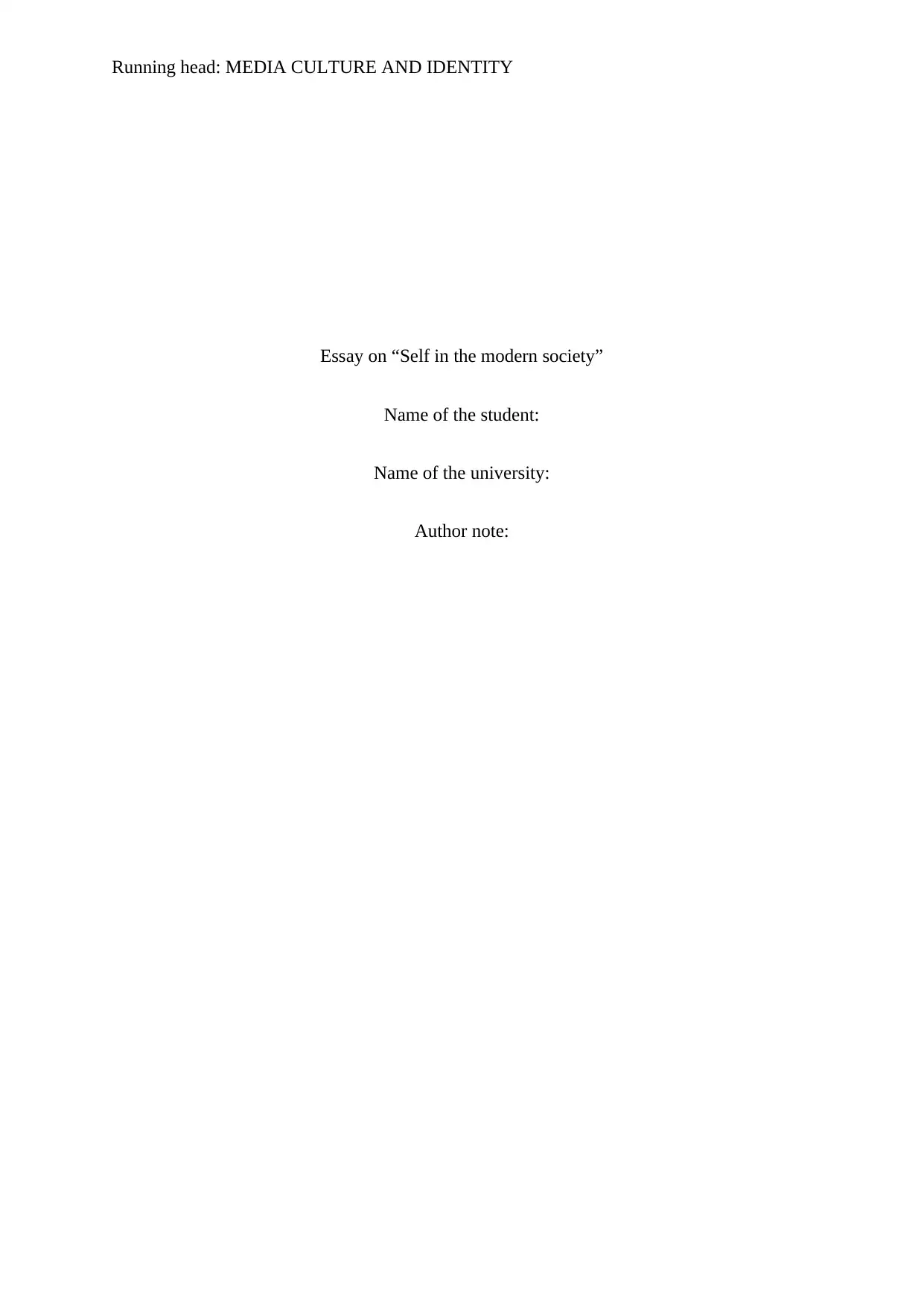
Running head: MEDIA CULTURE AND IDENTITY
Essay on “Self in the modern society”
Name of the student:
Name of the university:
Author note:
Essay on “Self in the modern society”
Name of the student:
Name of the university:
Author note:
Secure Best Marks with AI Grader
Need help grading? Try our AI Grader for instant feedback on your assignments.
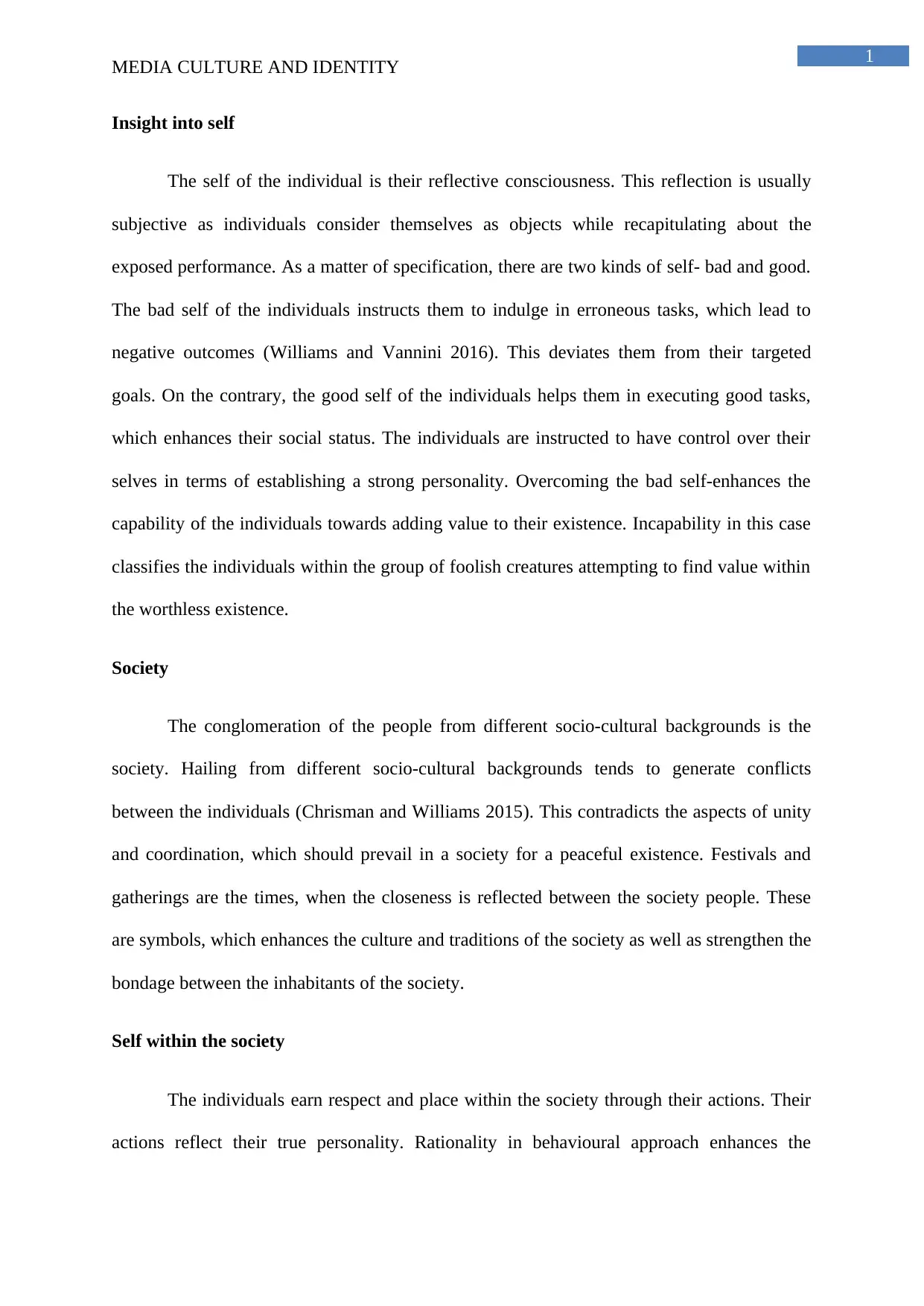
1
MEDIA CULTURE AND IDENTITY
Insight into self
The self of the individual is their reflective consciousness. This reflection is usually
subjective as individuals consider themselves as objects while recapitulating about the
exposed performance. As a matter of specification, there are two kinds of self- bad and good.
The bad self of the individuals instructs them to indulge in erroneous tasks, which lead to
negative outcomes (Williams and Vannini 2016). This deviates them from their targeted
goals. On the contrary, the good self of the individuals helps them in executing good tasks,
which enhances their social status. The individuals are instructed to have control over their
selves in terms of establishing a strong personality. Overcoming the bad self-enhances the
capability of the individuals towards adding value to their existence. Incapability in this case
classifies the individuals within the group of foolish creatures attempting to find value within
the worthless existence.
Society
The conglomeration of the people from different socio-cultural backgrounds is the
society. Hailing from different socio-cultural backgrounds tends to generate conflicts
between the individuals (Chrisman and Williams 2015). This contradicts the aspects of unity
and coordination, which should prevail in a society for a peaceful existence. Festivals and
gatherings are the times, when the closeness is reflected between the society people. These
are symbols, which enhances the culture and traditions of the society as well as strengthen the
bondage between the inhabitants of the society.
Self within the society
The individuals earn respect and place within the society through their actions. Their
actions reflect their true personality. Rationality in behavioural approach enhances the
MEDIA CULTURE AND IDENTITY
Insight into self
The self of the individual is their reflective consciousness. This reflection is usually
subjective as individuals consider themselves as objects while recapitulating about the
exposed performance. As a matter of specification, there are two kinds of self- bad and good.
The bad self of the individuals instructs them to indulge in erroneous tasks, which lead to
negative outcomes (Williams and Vannini 2016). This deviates them from their targeted
goals. On the contrary, the good self of the individuals helps them in executing good tasks,
which enhances their social status. The individuals are instructed to have control over their
selves in terms of establishing a strong personality. Overcoming the bad self-enhances the
capability of the individuals towards adding value to their existence. Incapability in this case
classifies the individuals within the group of foolish creatures attempting to find value within
the worthless existence.
Society
The conglomeration of the people from different socio-cultural backgrounds is the
society. Hailing from different socio-cultural backgrounds tends to generate conflicts
between the individuals (Chrisman and Williams 2015). This contradicts the aspects of unity
and coordination, which should prevail in a society for a peaceful existence. Festivals and
gatherings are the times, when the closeness is reflected between the society people. These
are symbols, which enhances the culture and traditions of the society as well as strengthen the
bondage between the inhabitants of the society.
Self within the society
The individuals earn respect and place within the society through their actions. Their
actions reflect their true personality. Rationality in behavioural approach enhances the
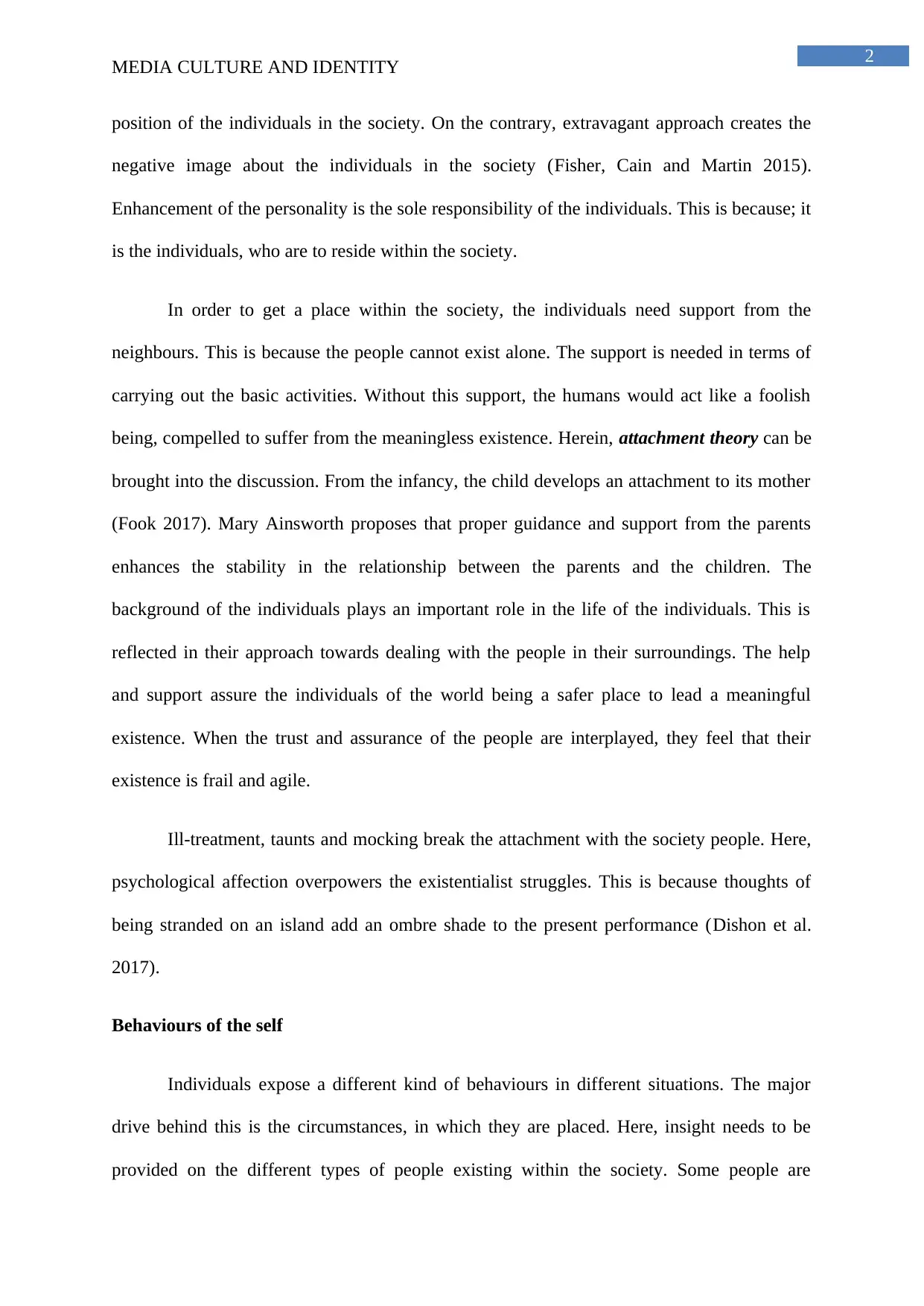
2
MEDIA CULTURE AND IDENTITY
position of the individuals in the society. On the contrary, extravagant approach creates the
negative image about the individuals in the society (Fisher, Cain and Martin 2015).
Enhancement of the personality is the sole responsibility of the individuals. This is because; it
is the individuals, who are to reside within the society.
In order to get a place within the society, the individuals need support from the
neighbours. This is because the people cannot exist alone. The support is needed in terms of
carrying out the basic activities. Without this support, the humans would act like a foolish
being, compelled to suffer from the meaningless existence. Herein, attachment theory can be
brought into the discussion. From the infancy, the child develops an attachment to its mother
(Fook 2017). Mary Ainsworth proposes that proper guidance and support from the parents
enhances the stability in the relationship between the parents and the children. The
background of the individuals plays an important role in the life of the individuals. This is
reflected in their approach towards dealing with the people in their surroundings. The help
and support assure the individuals of the world being a safer place to lead a meaningful
existence. When the trust and assurance of the people are interplayed, they feel that their
existence is frail and agile.
Ill-treatment, taunts and mocking break the attachment with the society people. Here,
psychological affection overpowers the existentialist struggles. This is because thoughts of
being stranded on an island add an ombre shade to the present performance (Dishon et al.
2017).
Behaviours of the self
Individuals expose a different kind of behaviours in different situations. The major
drive behind this is the circumstances, in which they are placed. Here, insight needs to be
provided on the different types of people existing within the society. Some people are
MEDIA CULTURE AND IDENTITY
position of the individuals in the society. On the contrary, extravagant approach creates the
negative image about the individuals in the society (Fisher, Cain and Martin 2015).
Enhancement of the personality is the sole responsibility of the individuals. This is because; it
is the individuals, who are to reside within the society.
In order to get a place within the society, the individuals need support from the
neighbours. This is because the people cannot exist alone. The support is needed in terms of
carrying out the basic activities. Without this support, the humans would act like a foolish
being, compelled to suffer from the meaningless existence. Herein, attachment theory can be
brought into the discussion. From the infancy, the child develops an attachment to its mother
(Fook 2017). Mary Ainsworth proposes that proper guidance and support from the parents
enhances the stability in the relationship between the parents and the children. The
background of the individuals plays an important role in the life of the individuals. This is
reflected in their approach towards dealing with the people in their surroundings. The help
and support assure the individuals of the world being a safer place to lead a meaningful
existence. When the trust and assurance of the people are interplayed, they feel that their
existence is frail and agile.
Ill-treatment, taunts and mocking break the attachment with the society people. Here,
psychological affection overpowers the existentialist struggles. This is because thoughts of
being stranded on an island add an ombre shade to the present performance (Dishon et al.
2017).
Behaviours of the self
Individuals expose a different kind of behaviours in different situations. The major
drive behind this is the circumstances, in which they are placed. Here, insight needs to be
provided on the different types of people existing within the society. Some people are
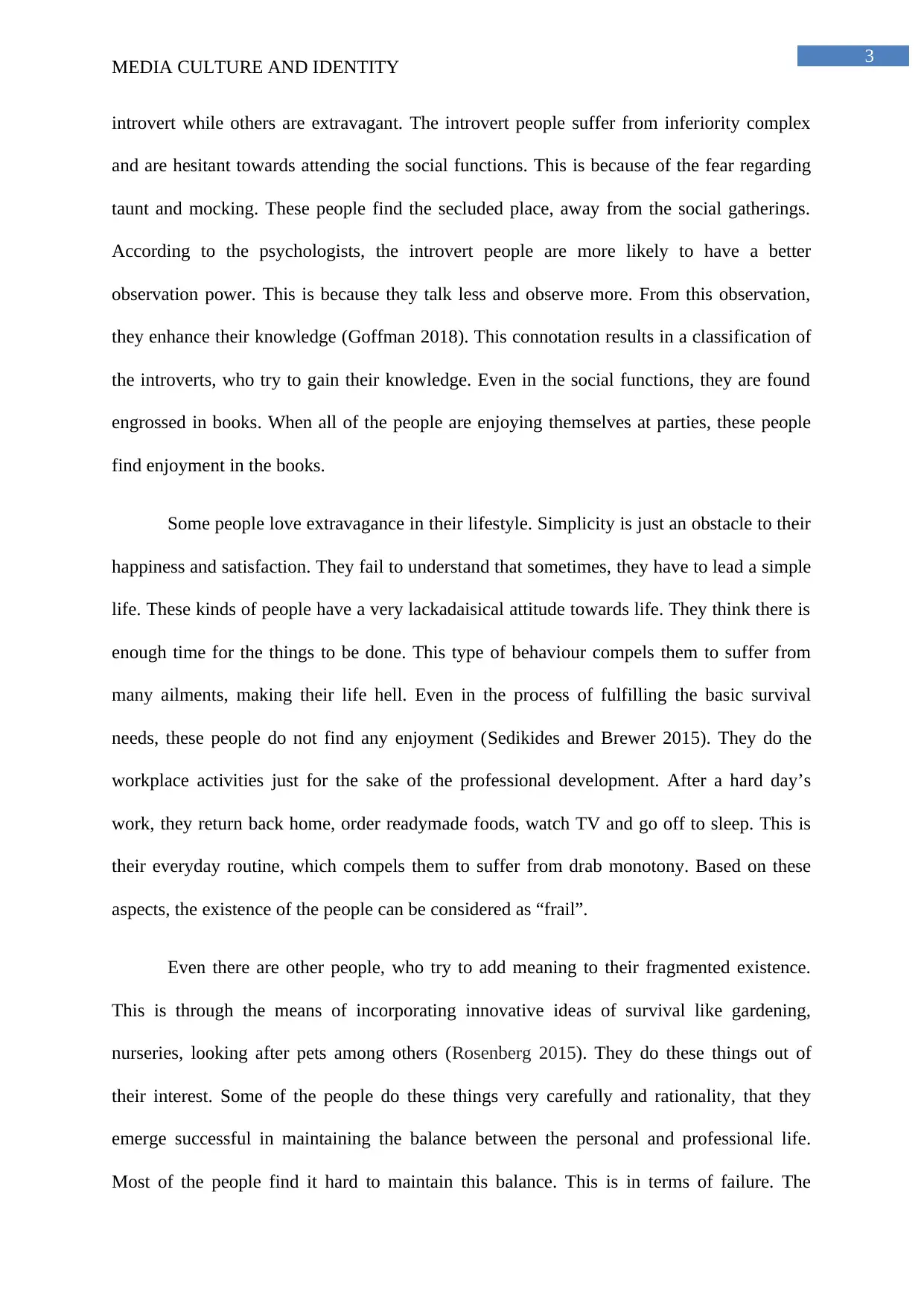
3
MEDIA CULTURE AND IDENTITY
introvert while others are extravagant. The introvert people suffer from inferiority complex
and are hesitant towards attending the social functions. This is because of the fear regarding
taunt and mocking. These people find the secluded place, away from the social gatherings.
According to the psychologists, the introvert people are more likely to have a better
observation power. This is because they talk less and observe more. From this observation,
they enhance their knowledge (Goffman 2018). This connotation results in a classification of
the introverts, who try to gain their knowledge. Even in the social functions, they are found
engrossed in books. When all of the people are enjoying themselves at parties, these people
find enjoyment in the books.
Some people love extravagance in their lifestyle. Simplicity is just an obstacle to their
happiness and satisfaction. They fail to understand that sometimes, they have to lead a simple
life. These kinds of people have a very lackadaisical attitude towards life. They think there is
enough time for the things to be done. This type of behaviour compels them to suffer from
many ailments, making their life hell. Even in the process of fulfilling the basic survival
needs, these people do not find any enjoyment (Sedikides and Brewer 2015). They do the
workplace activities just for the sake of the professional development. After a hard day’s
work, they return back home, order readymade foods, watch TV and go off to sleep. This is
their everyday routine, which compels them to suffer from drab monotony. Based on these
aspects, the existence of the people can be considered as “frail”.
Even there are other people, who try to add meaning to their fragmented existence.
This is through the means of incorporating innovative ideas of survival like gardening,
nurseries, looking after pets among others (Rosenberg 2015). They do these things out of
their interest. Some of the people do these things very carefully and rationality, that they
emerge successful in maintaining the balance between the personal and professional life.
Most of the people find it hard to maintain this balance. This is in terms of failure. The
MEDIA CULTURE AND IDENTITY
introvert while others are extravagant. The introvert people suffer from inferiority complex
and are hesitant towards attending the social functions. This is because of the fear regarding
taunt and mocking. These people find the secluded place, away from the social gatherings.
According to the psychologists, the introvert people are more likely to have a better
observation power. This is because they talk less and observe more. From this observation,
they enhance their knowledge (Goffman 2018). This connotation results in a classification of
the introverts, who try to gain their knowledge. Even in the social functions, they are found
engrossed in books. When all of the people are enjoying themselves at parties, these people
find enjoyment in the books.
Some people love extravagance in their lifestyle. Simplicity is just an obstacle to their
happiness and satisfaction. They fail to understand that sometimes, they have to lead a simple
life. These kinds of people have a very lackadaisical attitude towards life. They think there is
enough time for the things to be done. This type of behaviour compels them to suffer from
many ailments, making their life hell. Even in the process of fulfilling the basic survival
needs, these people do not find any enjoyment (Sedikides and Brewer 2015). They do the
workplace activities just for the sake of the professional development. After a hard day’s
work, they return back home, order readymade foods, watch TV and go off to sleep. This is
their everyday routine, which compels them to suffer from drab monotony. Based on these
aspects, the existence of the people can be considered as “frail”.
Even there are other people, who try to add meaning to their fragmented existence.
This is through the means of incorporating innovative ideas of survival like gardening,
nurseries, looking after pets among others (Rosenberg 2015). They do these things out of
their interest. Some of the people do these things very carefully and rationality, that they
emerge successful in maintaining the balance between the personal and professional life.
Most of the people find it hard to maintain this balance. This is in terms of failure. The
Secure Best Marks with AI Grader
Need help grading? Try our AI Grader for instant feedback on your assignments.
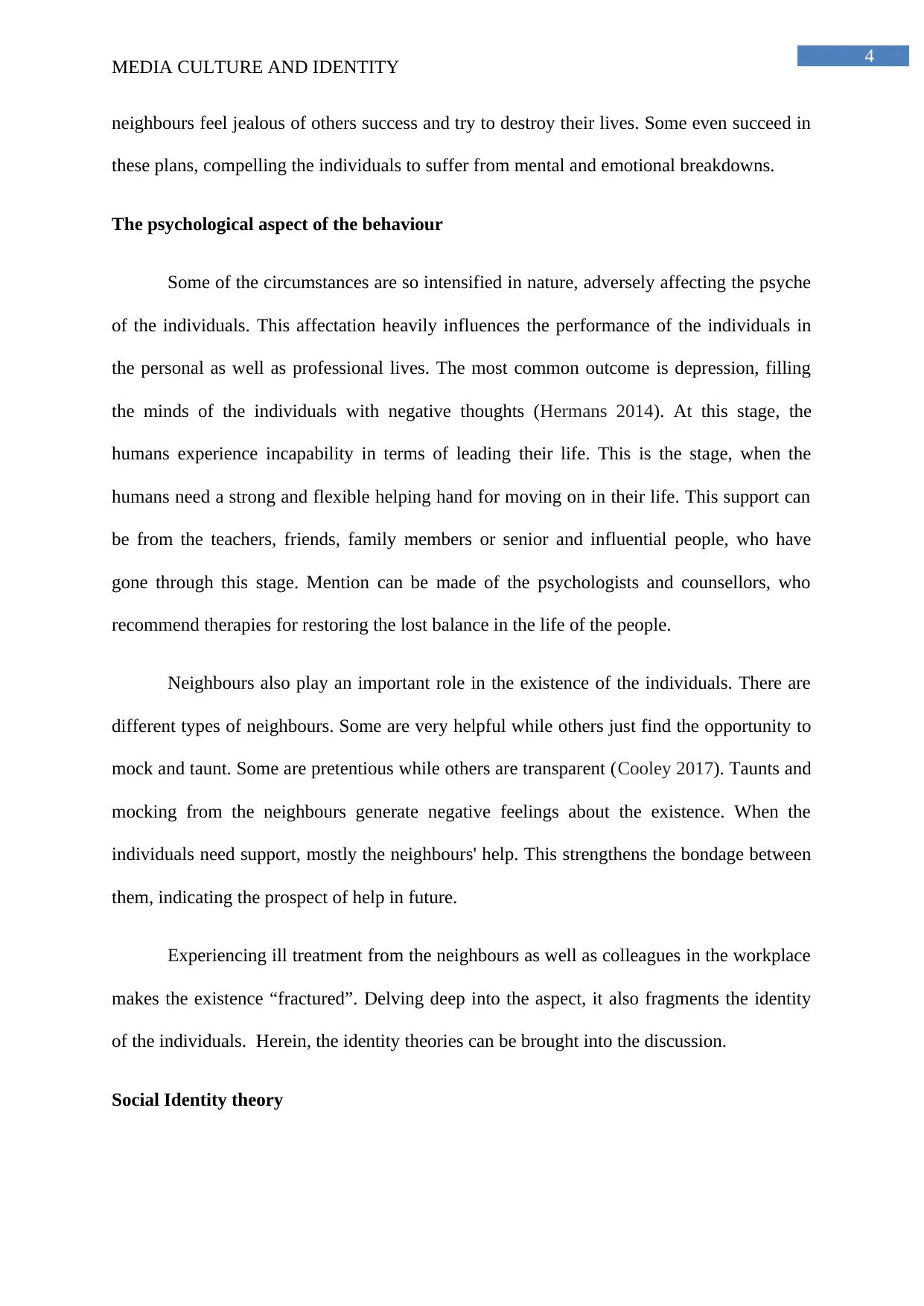
4
MEDIA CULTURE AND IDENTITY
neighbours feel jealous of others success and try to destroy their lives. Some even succeed in
these plans, compelling the individuals to suffer from mental and emotional breakdowns.
The psychological aspect of the behaviour
Some of the circumstances are so intensified in nature, adversely affecting the psyche
of the individuals. This affectation heavily influences the performance of the individuals in
the personal as well as professional lives. The most common outcome is depression, filling
the minds of the individuals with negative thoughts (Hermans 2014). At this stage, the
humans experience incapability in terms of leading their life. This is the stage, when the
humans need a strong and flexible helping hand for moving on in their life. This support can
be from the teachers, friends, family members or senior and influential people, who have
gone through this stage. Mention can be made of the psychologists and counsellors, who
recommend therapies for restoring the lost balance in the life of the people.
Neighbours also play an important role in the existence of the individuals. There are
different types of neighbours. Some are very helpful while others just find the opportunity to
mock and taunt. Some are pretentious while others are transparent (Cooley 2017). Taunts and
mocking from the neighbours generate negative feelings about the existence. When the
individuals need support, mostly the neighbours' help. This strengthens the bondage between
them, indicating the prospect of help in future.
Experiencing ill treatment from the neighbours as well as colleagues in the workplace
makes the existence “fractured”. Delving deep into the aspect, it also fragments the identity
of the individuals. Herein, the identity theories can be brought into the discussion.
Social Identity theory
MEDIA CULTURE AND IDENTITY
neighbours feel jealous of others success and try to destroy their lives. Some even succeed in
these plans, compelling the individuals to suffer from mental and emotional breakdowns.
The psychological aspect of the behaviour
Some of the circumstances are so intensified in nature, adversely affecting the psyche
of the individuals. This affectation heavily influences the performance of the individuals in
the personal as well as professional lives. The most common outcome is depression, filling
the minds of the individuals with negative thoughts (Hermans 2014). At this stage, the
humans experience incapability in terms of leading their life. This is the stage, when the
humans need a strong and flexible helping hand for moving on in their life. This support can
be from the teachers, friends, family members or senior and influential people, who have
gone through this stage. Mention can be made of the psychologists and counsellors, who
recommend therapies for restoring the lost balance in the life of the people.
Neighbours also play an important role in the existence of the individuals. There are
different types of neighbours. Some are very helpful while others just find the opportunity to
mock and taunt. Some are pretentious while others are transparent (Cooley 2017). Taunts and
mocking from the neighbours generate negative feelings about the existence. When the
individuals need support, mostly the neighbours' help. This strengthens the bondage between
them, indicating the prospect of help in future.
Experiencing ill treatment from the neighbours as well as colleagues in the workplace
makes the existence “fractured”. Delving deep into the aspect, it also fragments the identity
of the individuals. Herein, the identity theories can be brought into the discussion.
Social Identity theory
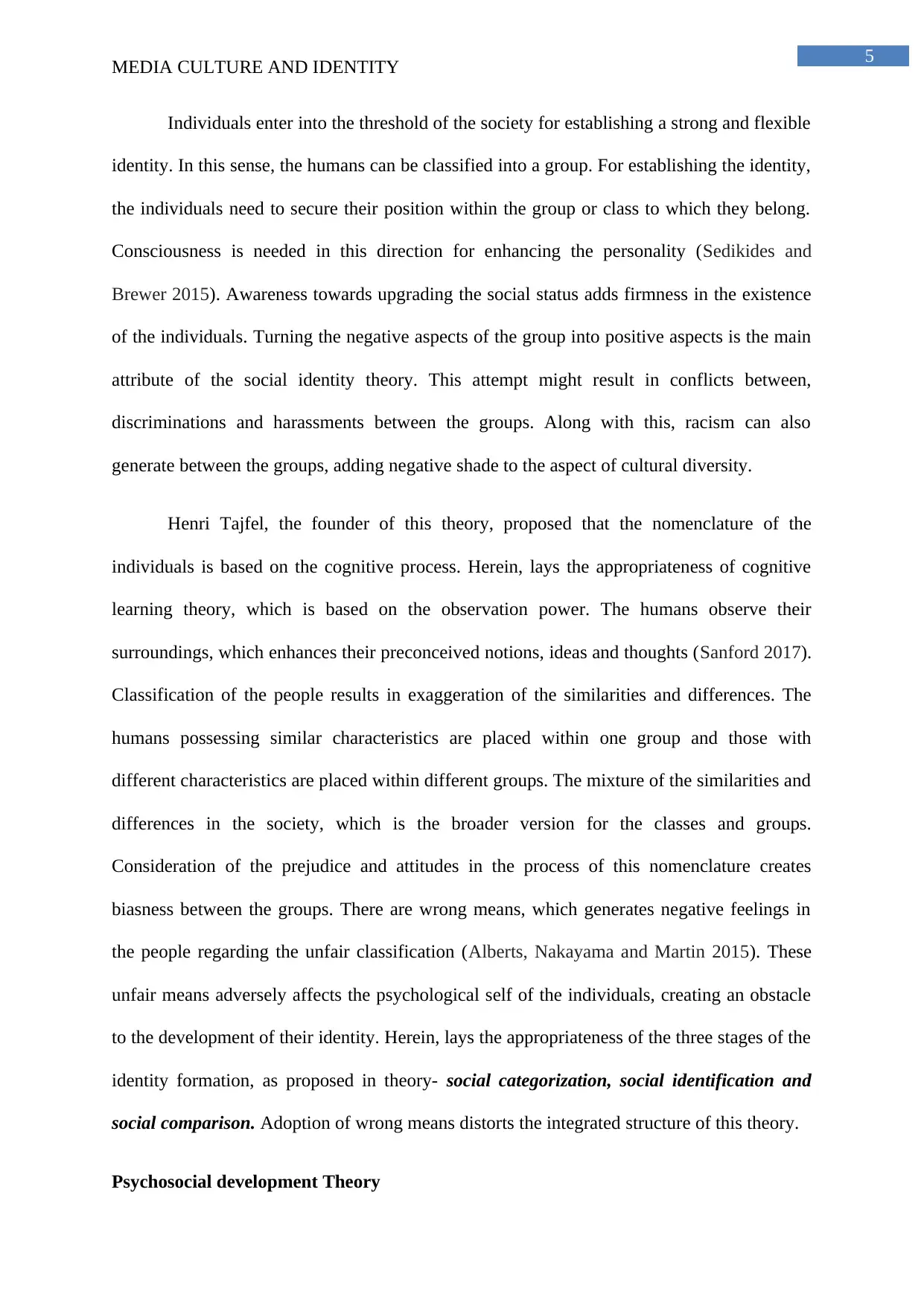
5
MEDIA CULTURE AND IDENTITY
Individuals enter into the threshold of the society for establishing a strong and flexible
identity. In this sense, the humans can be classified into a group. For establishing the identity,
the individuals need to secure their position within the group or class to which they belong.
Consciousness is needed in this direction for enhancing the personality (Sedikides and
Brewer 2015). Awareness towards upgrading the social status adds firmness in the existence
of the individuals. Turning the negative aspects of the group into positive aspects is the main
attribute of the social identity theory. This attempt might result in conflicts between,
discriminations and harassments between the groups. Along with this, racism can also
generate between the groups, adding negative shade to the aspect of cultural diversity.
Henri Tajfel, the founder of this theory, proposed that the nomenclature of the
individuals is based on the cognitive process. Herein, lays the appropriateness of cognitive
learning theory, which is based on the observation power. The humans observe their
surroundings, which enhances their preconceived notions, ideas and thoughts (Sanford 2017).
Classification of the people results in exaggeration of the similarities and differences. The
humans possessing similar characteristics are placed within one group and those with
different characteristics are placed within different groups. The mixture of the similarities and
differences in the society, which is the broader version for the classes and groups.
Consideration of the prejudice and attitudes in the process of this nomenclature creates
biasness between the groups. There are wrong means, which generates negative feelings in
the people regarding the unfair classification (Alberts, Nakayama and Martin 2015). These
unfair means adversely affects the psychological self of the individuals, creating an obstacle
to the development of their identity. Herein, lays the appropriateness of the three stages of the
identity formation, as proposed in theory- social categorization, social identification and
social comparison. Adoption of wrong means distorts the integrated structure of this theory.
Psychosocial development Theory
MEDIA CULTURE AND IDENTITY
Individuals enter into the threshold of the society for establishing a strong and flexible
identity. In this sense, the humans can be classified into a group. For establishing the identity,
the individuals need to secure their position within the group or class to which they belong.
Consciousness is needed in this direction for enhancing the personality (Sedikides and
Brewer 2015). Awareness towards upgrading the social status adds firmness in the existence
of the individuals. Turning the negative aspects of the group into positive aspects is the main
attribute of the social identity theory. This attempt might result in conflicts between,
discriminations and harassments between the groups. Along with this, racism can also
generate between the groups, adding negative shade to the aspect of cultural diversity.
Henri Tajfel, the founder of this theory, proposed that the nomenclature of the
individuals is based on the cognitive process. Herein, lays the appropriateness of cognitive
learning theory, which is based on the observation power. The humans observe their
surroundings, which enhances their preconceived notions, ideas and thoughts (Sanford 2017).
Classification of the people results in exaggeration of the similarities and differences. The
humans possessing similar characteristics are placed within one group and those with
different characteristics are placed within different groups. The mixture of the similarities and
differences in the society, which is the broader version for the classes and groups.
Consideration of the prejudice and attitudes in the process of this nomenclature creates
biasness between the groups. There are wrong means, which generates negative feelings in
the people regarding the unfair classification (Alberts, Nakayama and Martin 2015). These
unfair means adversely affects the psychological self of the individuals, creating an obstacle
to the development of their identity. Herein, lays the appropriateness of the three stages of the
identity formation, as proposed in theory- social categorization, social identification and
social comparison. Adoption of wrong means distorts the integrated structure of this theory.
Psychosocial development Theory
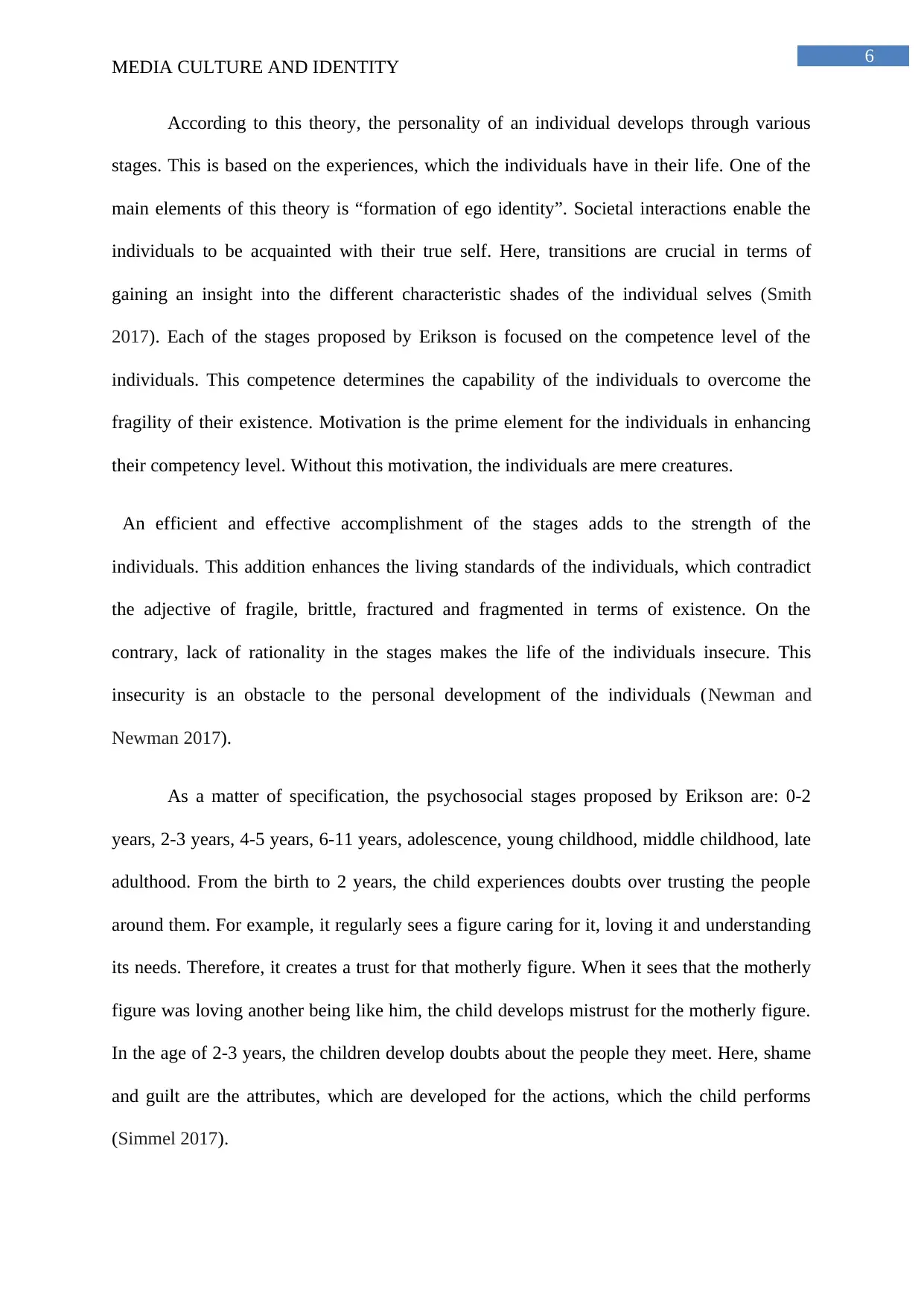
6
MEDIA CULTURE AND IDENTITY
According to this theory, the personality of an individual develops through various
stages. This is based on the experiences, which the individuals have in their life. One of the
main elements of this theory is “formation of ego identity”. Societal interactions enable the
individuals to be acquainted with their true self. Here, transitions are crucial in terms of
gaining an insight into the different characteristic shades of the individual selves (Smith
2017). Each of the stages proposed by Erikson is focused on the competence level of the
individuals. This competence determines the capability of the individuals to overcome the
fragility of their existence. Motivation is the prime element for the individuals in enhancing
their competency level. Without this motivation, the individuals are mere creatures.
An efficient and effective accomplishment of the stages adds to the strength of the
individuals. This addition enhances the living standards of the individuals, which contradict
the adjective of fragile, brittle, fractured and fragmented in terms of existence. On the
contrary, lack of rationality in the stages makes the life of the individuals insecure. This
insecurity is an obstacle to the personal development of the individuals (Newman and
Newman 2017).
As a matter of specification, the psychosocial stages proposed by Erikson are: 0-2
years, 2-3 years, 4-5 years, 6-11 years, adolescence, young childhood, middle childhood, late
adulthood. From the birth to 2 years, the child experiences doubts over trusting the people
around them. For example, it regularly sees a figure caring for it, loving it and understanding
its needs. Therefore, it creates a trust for that motherly figure. When it sees that the motherly
figure was loving another being like him, the child develops mistrust for the motherly figure.
In the age of 2-3 years, the children develop doubts about the people they meet. Here, shame
and guilt are the attributes, which are developed for the actions, which the child performs
(Simmel 2017).
MEDIA CULTURE AND IDENTITY
According to this theory, the personality of an individual develops through various
stages. This is based on the experiences, which the individuals have in their life. One of the
main elements of this theory is “formation of ego identity”. Societal interactions enable the
individuals to be acquainted with their true self. Here, transitions are crucial in terms of
gaining an insight into the different characteristic shades of the individual selves (Smith
2017). Each of the stages proposed by Erikson is focused on the competence level of the
individuals. This competence determines the capability of the individuals to overcome the
fragility of their existence. Motivation is the prime element for the individuals in enhancing
their competency level. Without this motivation, the individuals are mere creatures.
An efficient and effective accomplishment of the stages adds to the strength of the
individuals. This addition enhances the living standards of the individuals, which contradict
the adjective of fragile, brittle, fractured and fragmented in terms of existence. On the
contrary, lack of rationality in the stages makes the life of the individuals insecure. This
insecurity is an obstacle to the personal development of the individuals (Newman and
Newman 2017).
As a matter of specification, the psychosocial stages proposed by Erikson are: 0-2
years, 2-3 years, 4-5 years, 6-11 years, adolescence, young childhood, middle childhood, late
adulthood. From the birth to 2 years, the child experiences doubts over trusting the people
around them. For example, it regularly sees a figure caring for it, loving it and understanding
its needs. Therefore, it creates a trust for that motherly figure. When it sees that the motherly
figure was loving another being like him, the child develops mistrust for the motherly figure.
In the age of 2-3 years, the children develop doubts about the people they meet. Here, shame
and guilt are the attributes, which are developed for the actions, which the child performs
(Simmel 2017).
Paraphrase This Document
Need a fresh take? Get an instant paraphrase of this document with our AI Paraphraser
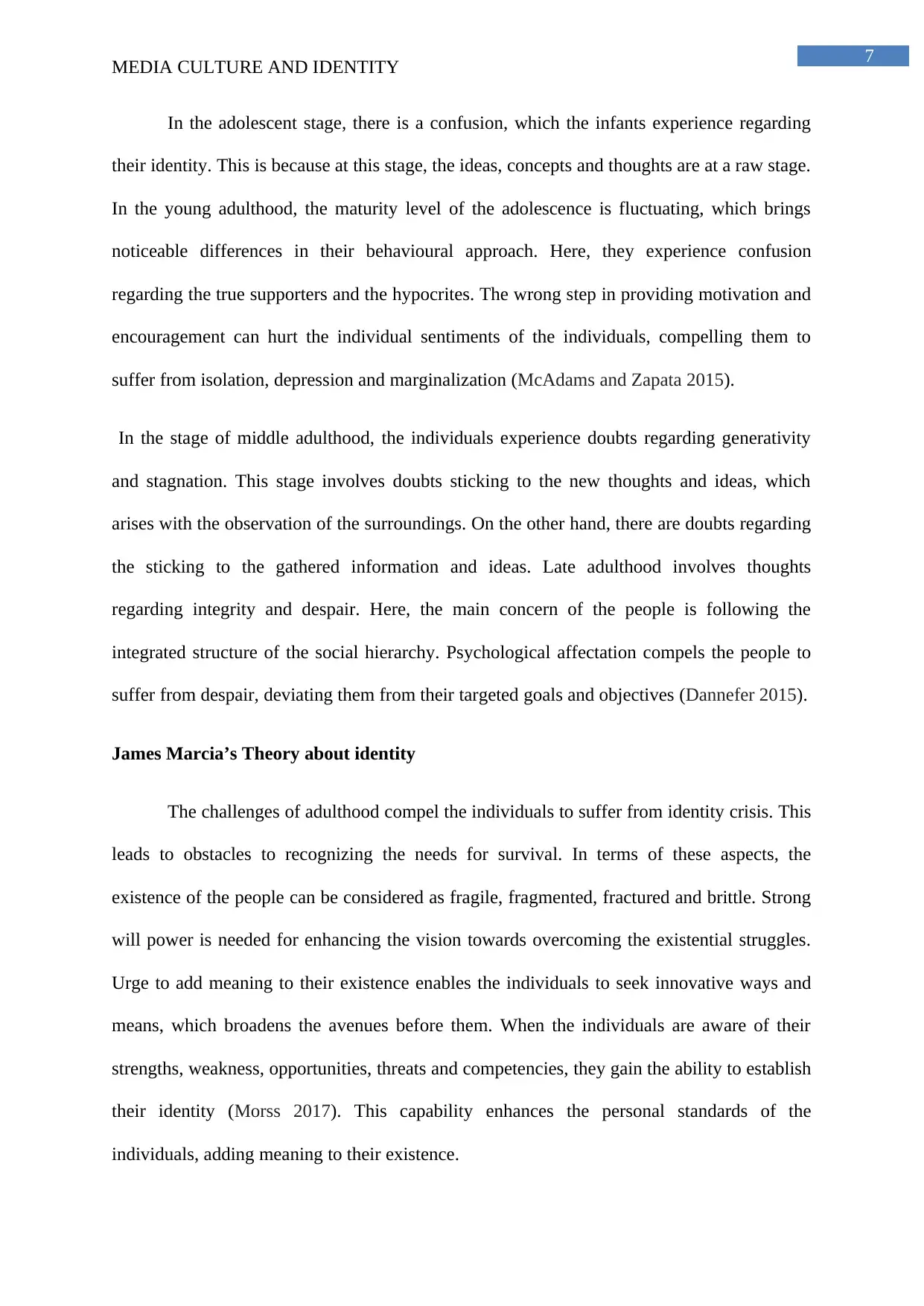
7
MEDIA CULTURE AND IDENTITY
In the adolescent stage, there is a confusion, which the infants experience regarding
their identity. This is because at this stage, the ideas, concepts and thoughts are at a raw stage.
In the young adulthood, the maturity level of the adolescence is fluctuating, which brings
noticeable differences in their behavioural approach. Here, they experience confusion
regarding the true supporters and the hypocrites. The wrong step in providing motivation and
encouragement can hurt the individual sentiments of the individuals, compelling them to
suffer from isolation, depression and marginalization (McAdams and Zapata 2015).
In the stage of middle adulthood, the individuals experience doubts regarding generativity
and stagnation. This stage involves doubts sticking to the new thoughts and ideas, which
arises with the observation of the surroundings. On the other hand, there are doubts regarding
the sticking to the gathered information and ideas. Late adulthood involves thoughts
regarding integrity and despair. Here, the main concern of the people is following the
integrated structure of the social hierarchy. Psychological affectation compels the people to
suffer from despair, deviating them from their targeted goals and objectives (Dannefer 2015).
James Marcia’s Theory about identity
The challenges of adulthood compel the individuals to suffer from identity crisis. This
leads to obstacles to recognizing the needs for survival. In terms of these aspects, the
existence of the people can be considered as fragile, fragmented, fractured and brittle. Strong
will power is needed for enhancing the vision towards overcoming the existential struggles.
Urge to add meaning to their existence enables the individuals to seek innovative ways and
means, which broadens the avenues before them. When the individuals are aware of their
strengths, weakness, opportunities, threats and competencies, they gain the ability to establish
their identity (Morss 2017). This capability enhances the personal standards of the
individuals, adding meaning to their existence.
MEDIA CULTURE AND IDENTITY
In the adolescent stage, there is a confusion, which the infants experience regarding
their identity. This is because at this stage, the ideas, concepts and thoughts are at a raw stage.
In the young adulthood, the maturity level of the adolescence is fluctuating, which brings
noticeable differences in their behavioural approach. Here, they experience confusion
regarding the true supporters and the hypocrites. The wrong step in providing motivation and
encouragement can hurt the individual sentiments of the individuals, compelling them to
suffer from isolation, depression and marginalization (McAdams and Zapata 2015).
In the stage of middle adulthood, the individuals experience doubts regarding generativity
and stagnation. This stage involves doubts sticking to the new thoughts and ideas, which
arises with the observation of the surroundings. On the other hand, there are doubts regarding
the sticking to the gathered information and ideas. Late adulthood involves thoughts
regarding integrity and despair. Here, the main concern of the people is following the
integrated structure of the social hierarchy. Psychological affectation compels the people to
suffer from despair, deviating them from their targeted goals and objectives (Dannefer 2015).
James Marcia’s Theory about identity
The challenges of adulthood compel the individuals to suffer from identity crisis. This
leads to obstacles to recognizing the needs for survival. In terms of these aspects, the
existence of the people can be considered as fragile, fragmented, fractured and brittle. Strong
will power is needed for enhancing the vision towards overcoming the existential struggles.
Urge to add meaning to their existence enables the individuals to seek innovative ways and
means, which broadens the avenues before them. When the individuals are aware of their
strengths, weakness, opportunities, threats and competencies, they gain the ability to establish
their identity (Morss 2017). This capability enhances the personal standards of the
individuals, adding meaning to their existence.
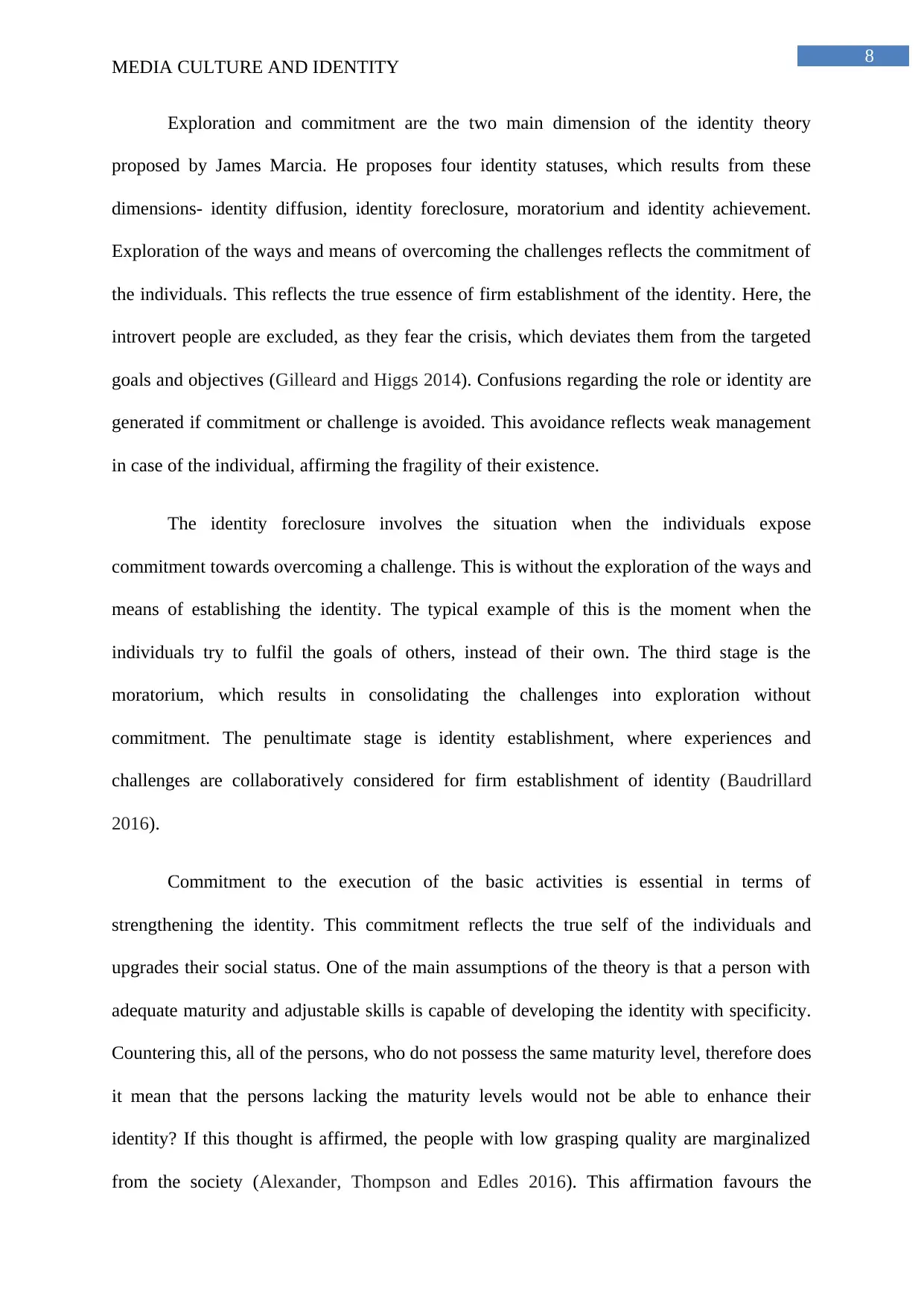
8
MEDIA CULTURE AND IDENTITY
Exploration and commitment are the two main dimension of the identity theory
proposed by James Marcia. He proposes four identity statuses, which results from these
dimensions- identity diffusion, identity foreclosure, moratorium and identity achievement.
Exploration of the ways and means of overcoming the challenges reflects the commitment of
the individuals. This reflects the true essence of firm establishment of the identity. Here, the
introvert people are excluded, as they fear the crisis, which deviates them from the targeted
goals and objectives (Gilleard and Higgs 2014). Confusions regarding the role or identity are
generated if commitment or challenge is avoided. This avoidance reflects weak management
in case of the individual, affirming the fragility of their existence.
The identity foreclosure involves the situation when the individuals expose
commitment towards overcoming a challenge. This is without the exploration of the ways and
means of establishing the identity. The typical example of this is the moment when the
individuals try to fulfil the goals of others, instead of their own. The third stage is the
moratorium, which results in consolidating the challenges into exploration without
commitment. The penultimate stage is identity establishment, where experiences and
challenges are collaboratively considered for firm establishment of identity (Baudrillard
2016).
Commitment to the execution of the basic activities is essential in terms of
strengthening the identity. This commitment reflects the true self of the individuals and
upgrades their social status. One of the main assumptions of the theory is that a person with
adequate maturity and adjustable skills is capable of developing the identity with specificity.
Countering this, all of the persons, who do not possess the same maturity level, therefore does
it mean that the persons lacking the maturity levels would not be able to enhance their
identity? If this thought is affirmed, the people with low grasping quality are marginalized
from the society (Alexander, Thompson and Edles 2016). This affirmation favours the
MEDIA CULTURE AND IDENTITY
Exploration and commitment are the two main dimension of the identity theory
proposed by James Marcia. He proposes four identity statuses, which results from these
dimensions- identity diffusion, identity foreclosure, moratorium and identity achievement.
Exploration of the ways and means of overcoming the challenges reflects the commitment of
the individuals. This reflects the true essence of firm establishment of the identity. Here, the
introvert people are excluded, as they fear the crisis, which deviates them from the targeted
goals and objectives (Gilleard and Higgs 2014). Confusions regarding the role or identity are
generated if commitment or challenge is avoided. This avoidance reflects weak management
in case of the individual, affirming the fragility of their existence.
The identity foreclosure involves the situation when the individuals expose
commitment towards overcoming a challenge. This is without the exploration of the ways and
means of establishing the identity. The typical example of this is the moment when the
individuals try to fulfil the goals of others, instead of their own. The third stage is the
moratorium, which results in consolidating the challenges into exploration without
commitment. The penultimate stage is identity establishment, where experiences and
challenges are collaboratively considered for firm establishment of identity (Baudrillard
2016).
Commitment to the execution of the basic activities is essential in terms of
strengthening the identity. This commitment reflects the true self of the individuals and
upgrades their social status. One of the main assumptions of the theory is that a person with
adequate maturity and adjustable skills is capable of developing the identity with specificity.
Countering this, all of the persons, who do not possess the same maturity level, therefore does
it mean that the persons lacking the maturity levels would not be able to enhance their
identity? If this thought is affirmed, the people with low grasping quality are marginalized
from the society (Alexander, Thompson and Edles 2016). This affirmation favours the
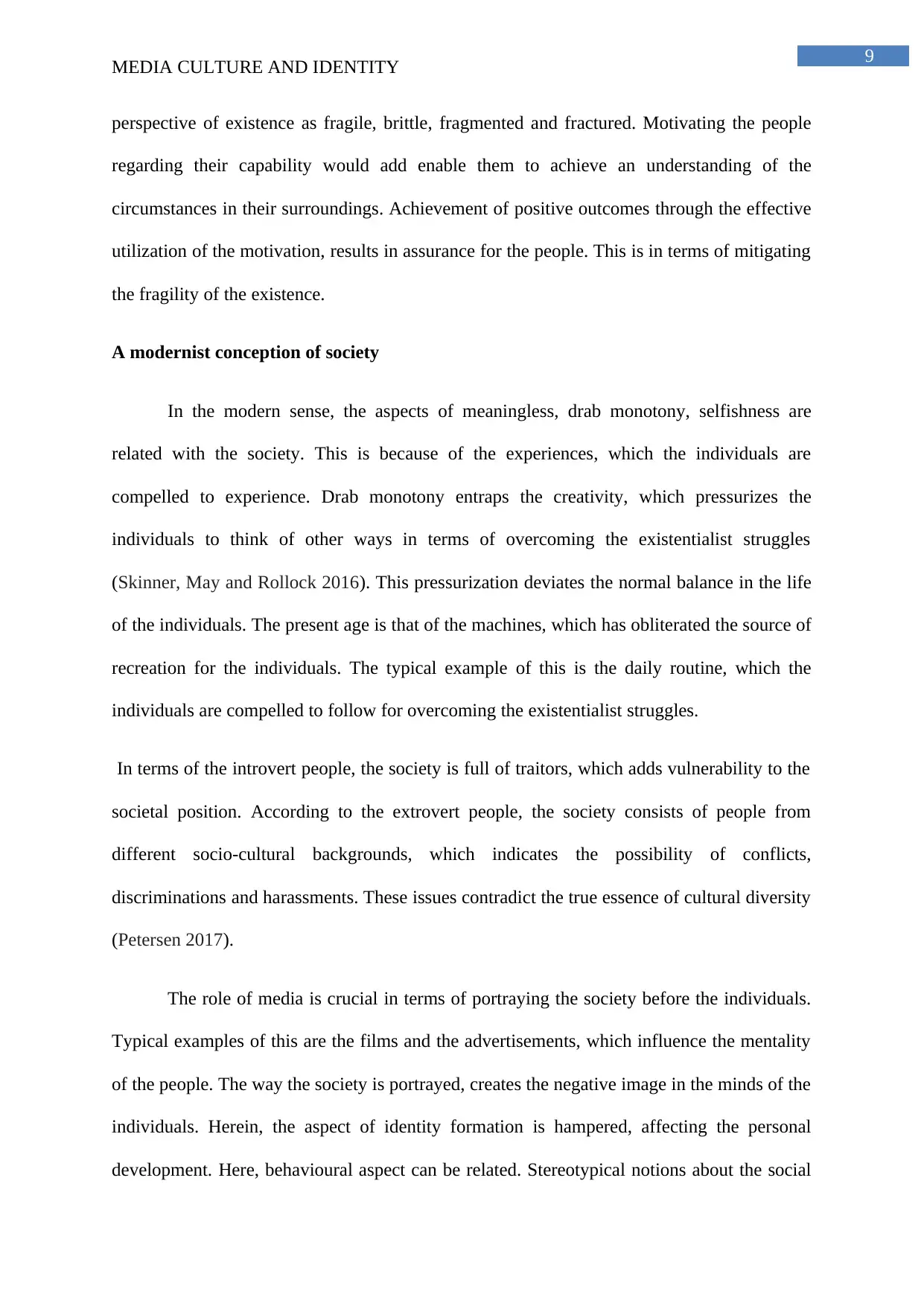
9
MEDIA CULTURE AND IDENTITY
perspective of existence as fragile, brittle, fragmented and fractured. Motivating the people
regarding their capability would add enable them to achieve an understanding of the
circumstances in their surroundings. Achievement of positive outcomes through the effective
utilization of the motivation, results in assurance for the people. This is in terms of mitigating
the fragility of the existence.
A modernist conception of society
In the modern sense, the aspects of meaningless, drab monotony, selfishness are
related with the society. This is because of the experiences, which the individuals are
compelled to experience. Drab monotony entraps the creativity, which pressurizes the
individuals to think of other ways in terms of overcoming the existentialist struggles
(Skinner, May and Rollock 2016). This pressurization deviates the normal balance in the life
of the individuals. The present age is that of the machines, which has obliterated the source of
recreation for the individuals. The typical example of this is the daily routine, which the
individuals are compelled to follow for overcoming the existentialist struggles.
In terms of the introvert people, the society is full of traitors, which adds vulnerability to the
societal position. According to the extrovert people, the society consists of people from
different socio-cultural backgrounds, which indicates the possibility of conflicts,
discriminations and harassments. These issues contradict the true essence of cultural diversity
(Petersen 2017).
The role of media is crucial in terms of portraying the society before the individuals.
Typical examples of this are the films and the advertisements, which influence the mentality
of the people. The way the society is portrayed, creates the negative image in the minds of the
individuals. Herein, the aspect of identity formation is hampered, affecting the personal
development. Here, behavioural aspect can be related. Stereotypical notions about the social
MEDIA CULTURE AND IDENTITY
perspective of existence as fragile, brittle, fragmented and fractured. Motivating the people
regarding their capability would add enable them to achieve an understanding of the
circumstances in their surroundings. Achievement of positive outcomes through the effective
utilization of the motivation, results in assurance for the people. This is in terms of mitigating
the fragility of the existence.
A modernist conception of society
In the modern sense, the aspects of meaningless, drab monotony, selfishness are
related with the society. This is because of the experiences, which the individuals are
compelled to experience. Drab monotony entraps the creativity, which pressurizes the
individuals to think of other ways in terms of overcoming the existentialist struggles
(Skinner, May and Rollock 2016). This pressurization deviates the normal balance in the life
of the individuals. The present age is that of the machines, which has obliterated the source of
recreation for the individuals. The typical example of this is the daily routine, which the
individuals are compelled to follow for overcoming the existentialist struggles.
In terms of the introvert people, the society is full of traitors, which adds vulnerability to the
societal position. According to the extrovert people, the society consists of people from
different socio-cultural backgrounds, which indicates the possibility of conflicts,
discriminations and harassments. These issues contradict the true essence of cultural diversity
(Petersen 2017).
The role of media is crucial in terms of portraying the society before the individuals.
Typical examples of this are the films and the advertisements, which influence the mentality
of the people. The way the society is portrayed, creates the negative image in the minds of the
individuals. Herein, the aspect of identity formation is hampered, affecting the personal
development. Here, behavioural aspect can be related. Stereotypical notions about the social
Secure Best Marks with AI Grader
Need help grading? Try our AI Grader for instant feedback on your assignments.
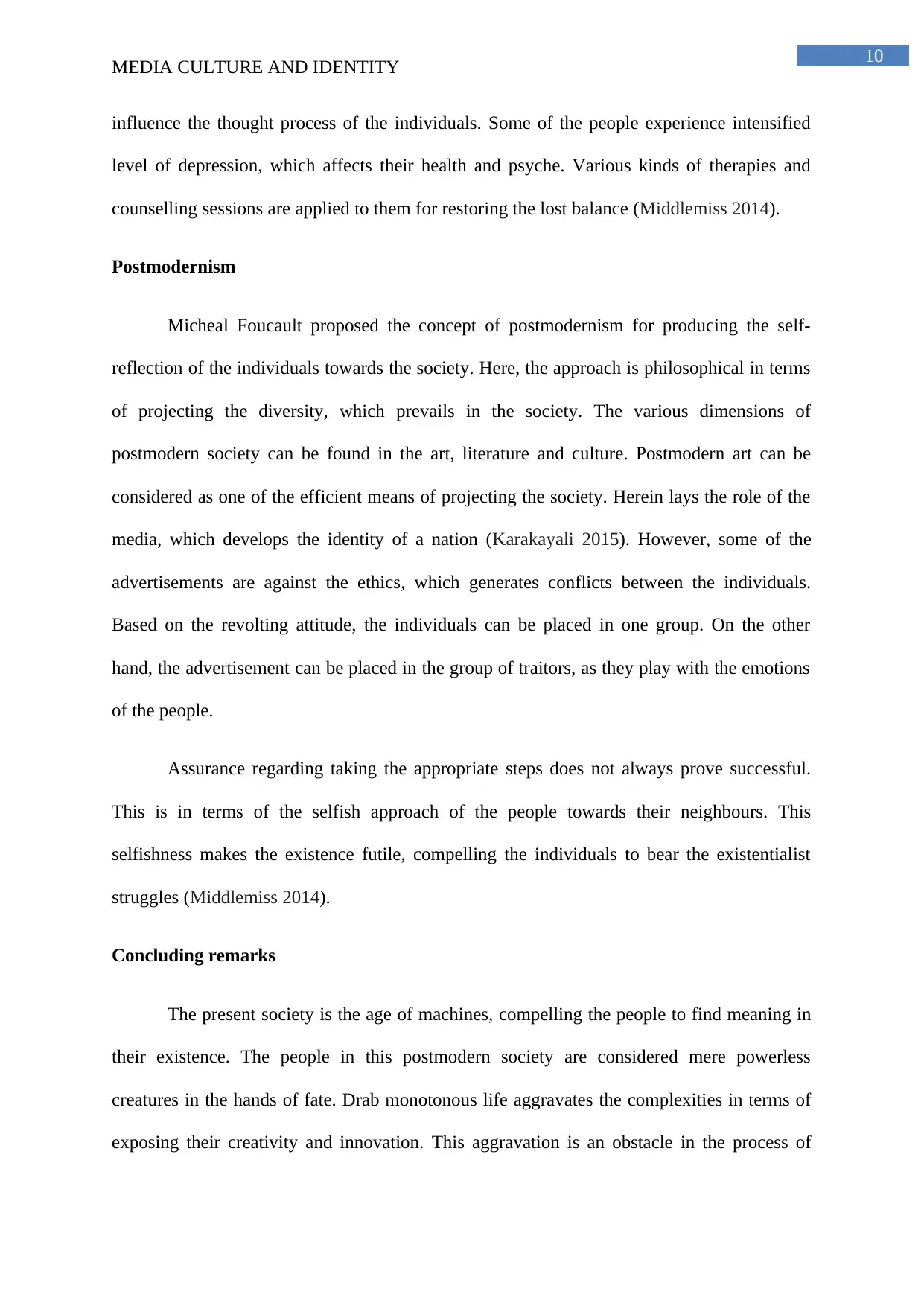
10
MEDIA CULTURE AND IDENTITY
influence the thought process of the individuals. Some of the people experience intensified
level of depression, which affects their health and psyche. Various kinds of therapies and
counselling sessions are applied to them for restoring the lost balance (Middlemiss 2014).
Postmodernism
Micheal Foucault proposed the concept of postmodernism for producing the self-
reflection of the individuals towards the society. Here, the approach is philosophical in terms
of projecting the diversity, which prevails in the society. The various dimensions of
postmodern society can be found in the art, literature and culture. Postmodern art can be
considered as one of the efficient means of projecting the society. Herein lays the role of the
media, which develops the identity of a nation (Karakayali 2015). However, some of the
advertisements are against the ethics, which generates conflicts between the individuals.
Based on the revolting attitude, the individuals can be placed in one group. On the other
hand, the advertisement can be placed in the group of traitors, as they play with the emotions
of the people.
Assurance regarding taking the appropriate steps does not always prove successful.
This is in terms of the selfish approach of the people towards their neighbours. This
selfishness makes the existence futile, compelling the individuals to bear the existentialist
struggles (Middlemiss 2014).
Concluding remarks
The present society is the age of machines, compelling the people to find meaning in
their existence. The people in this postmodern society are considered mere powerless
creatures in the hands of fate. Drab monotonous life aggravates the complexities in terms of
exposing their creativity and innovation. This aggravation is an obstacle in the process of
MEDIA CULTURE AND IDENTITY
influence the thought process of the individuals. Some of the people experience intensified
level of depression, which affects their health and psyche. Various kinds of therapies and
counselling sessions are applied to them for restoring the lost balance (Middlemiss 2014).
Postmodernism
Micheal Foucault proposed the concept of postmodernism for producing the self-
reflection of the individuals towards the society. Here, the approach is philosophical in terms
of projecting the diversity, which prevails in the society. The various dimensions of
postmodern society can be found in the art, literature and culture. Postmodern art can be
considered as one of the efficient means of projecting the society. Herein lays the role of the
media, which develops the identity of a nation (Karakayali 2015). However, some of the
advertisements are against the ethics, which generates conflicts between the individuals.
Based on the revolting attitude, the individuals can be placed in one group. On the other
hand, the advertisement can be placed in the group of traitors, as they play with the emotions
of the people.
Assurance regarding taking the appropriate steps does not always prove successful.
This is in terms of the selfish approach of the people towards their neighbours. This
selfishness makes the existence futile, compelling the individuals to bear the existentialist
struggles (Middlemiss 2014).
Concluding remarks
The present society is the age of machines, compelling the people to find meaning in
their existence. The people in this postmodern society are considered mere powerless
creatures in the hands of fate. Drab monotonous life aggravates the complexities in terms of
exposing their creativity and innovation. This aggravation is an obstacle in the process of
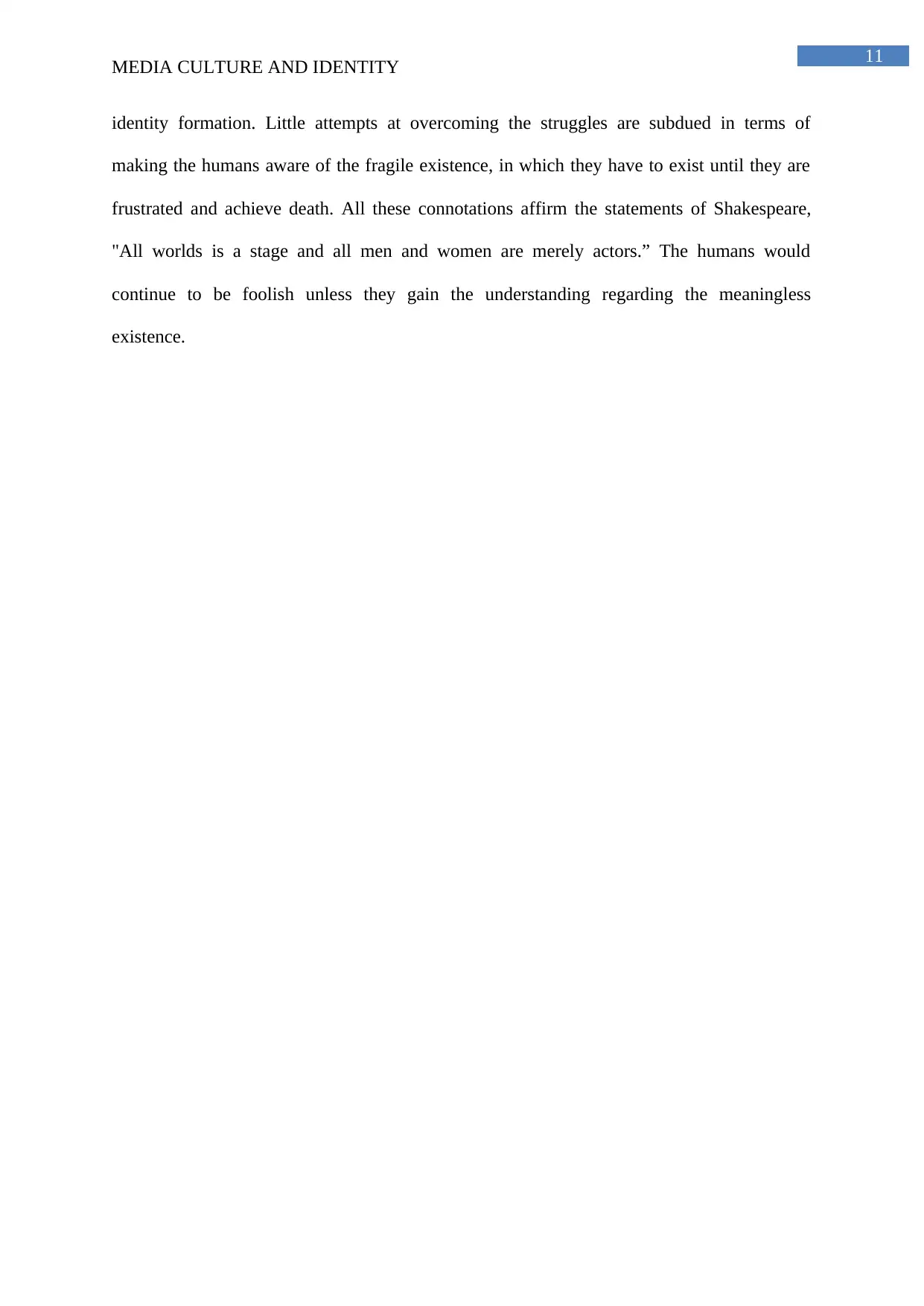
11
MEDIA CULTURE AND IDENTITY
identity formation. Little attempts at overcoming the struggles are subdued in terms of
making the humans aware of the fragile existence, in which they have to exist until they are
frustrated and achieve death. All these connotations affirm the statements of Shakespeare,
"All worlds is a stage and all men and women are merely actors.” The humans would
continue to be foolish unless they gain the understanding regarding the meaningless
existence.
MEDIA CULTURE AND IDENTITY
identity formation. Little attempts at overcoming the struggles are subdued in terms of
making the humans aware of the fragile existence, in which they have to exist until they are
frustrated and achieve death. All these connotations affirm the statements of Shakespeare,
"All worlds is a stage and all men and women are merely actors.” The humans would
continue to be foolish unless they gain the understanding regarding the meaningless
existence.
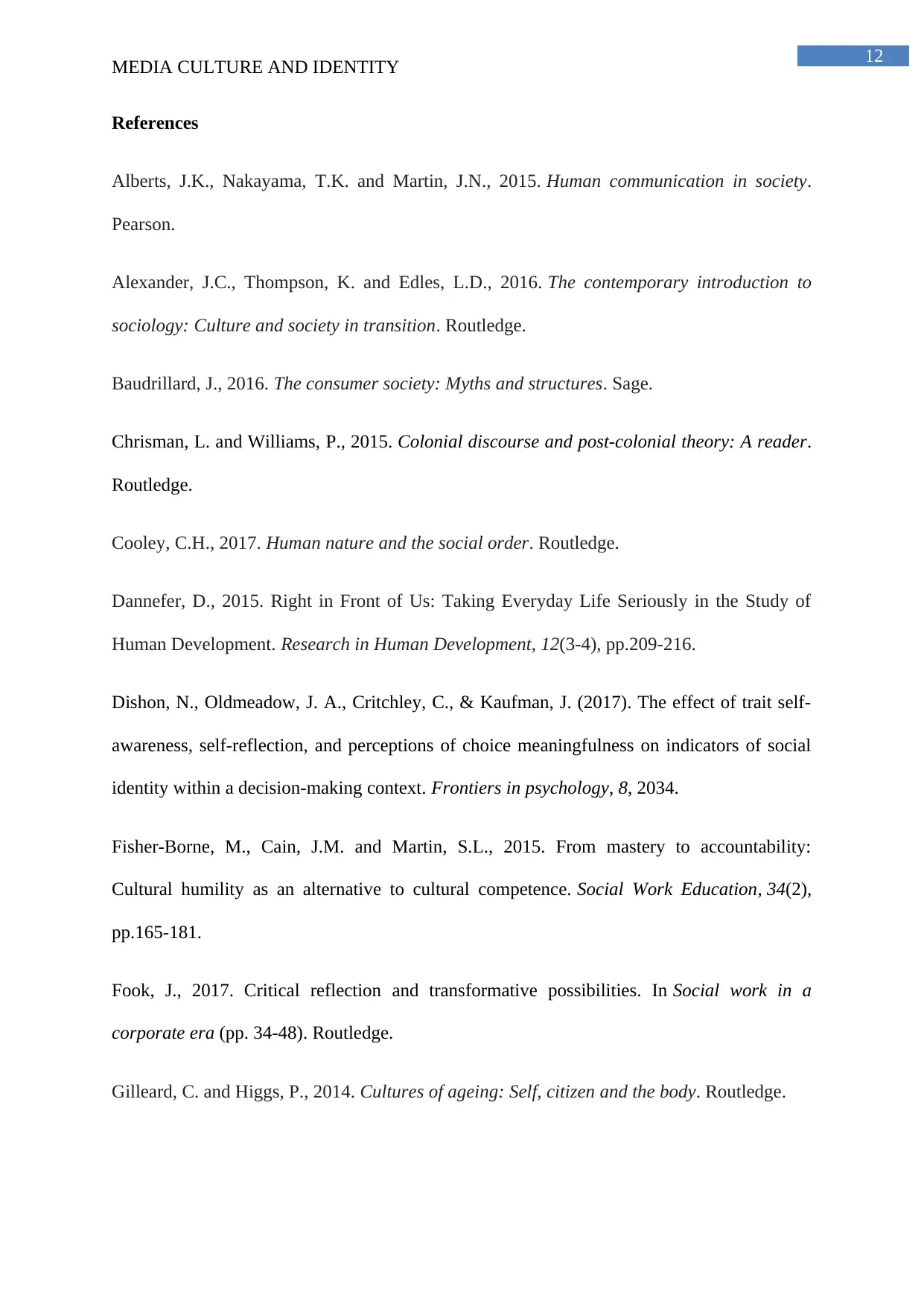
12
MEDIA CULTURE AND IDENTITY
References
Alberts, J.K., Nakayama, T.K. and Martin, J.N., 2015. Human communication in society.
Pearson.
Alexander, J.C., Thompson, K. and Edles, L.D., 2016. The contemporary introduction to
sociology: Culture and society in transition. Routledge.
Baudrillard, J., 2016. The consumer society: Myths and structures. Sage.
Chrisman, L. and Williams, P., 2015. Colonial discourse and post-colonial theory: A reader.
Routledge.
Cooley, C.H., 2017. Human nature and the social order. Routledge.
Dannefer, D., 2015. Right in Front of Us: Taking Everyday Life Seriously in the Study of
Human Development. Research in Human Development, 12(3-4), pp.209-216.
Dishon, N., Oldmeadow, J. A., Critchley, C., & Kaufman, J. (2017). The effect of trait self-
awareness, self-reflection, and perceptions of choice meaningfulness on indicators of social
identity within a decision-making context. Frontiers in psychology, 8, 2034.
Fisher-Borne, M., Cain, J.M. and Martin, S.L., 2015. From mastery to accountability:
Cultural humility as an alternative to cultural competence. Social Work Education, 34(2),
pp.165-181.
Fook, J., 2017. Critical reflection and transformative possibilities. In Social work in a
corporate era (pp. 34-48). Routledge.
Gilleard, C. and Higgs, P., 2014. Cultures of ageing: Self, citizen and the body. Routledge.
MEDIA CULTURE AND IDENTITY
References
Alberts, J.K., Nakayama, T.K. and Martin, J.N., 2015. Human communication in society.
Pearson.
Alexander, J.C., Thompson, K. and Edles, L.D., 2016. The contemporary introduction to
sociology: Culture and society in transition. Routledge.
Baudrillard, J., 2016. The consumer society: Myths and structures. Sage.
Chrisman, L. and Williams, P., 2015. Colonial discourse and post-colonial theory: A reader.
Routledge.
Cooley, C.H., 2017. Human nature and the social order. Routledge.
Dannefer, D., 2015. Right in Front of Us: Taking Everyday Life Seriously in the Study of
Human Development. Research in Human Development, 12(3-4), pp.209-216.
Dishon, N., Oldmeadow, J. A., Critchley, C., & Kaufman, J. (2017). The effect of trait self-
awareness, self-reflection, and perceptions of choice meaningfulness on indicators of social
identity within a decision-making context. Frontiers in psychology, 8, 2034.
Fisher-Borne, M., Cain, J.M. and Martin, S.L., 2015. From mastery to accountability:
Cultural humility as an alternative to cultural competence. Social Work Education, 34(2),
pp.165-181.
Fook, J., 2017. Critical reflection and transformative possibilities. In Social work in a
corporate era (pp. 34-48). Routledge.
Gilleard, C. and Higgs, P., 2014. Cultures of ageing: Self, citizen and the body. Routledge.
Paraphrase This Document
Need a fresh take? Get an instant paraphrase of this document with our AI Paraphraser
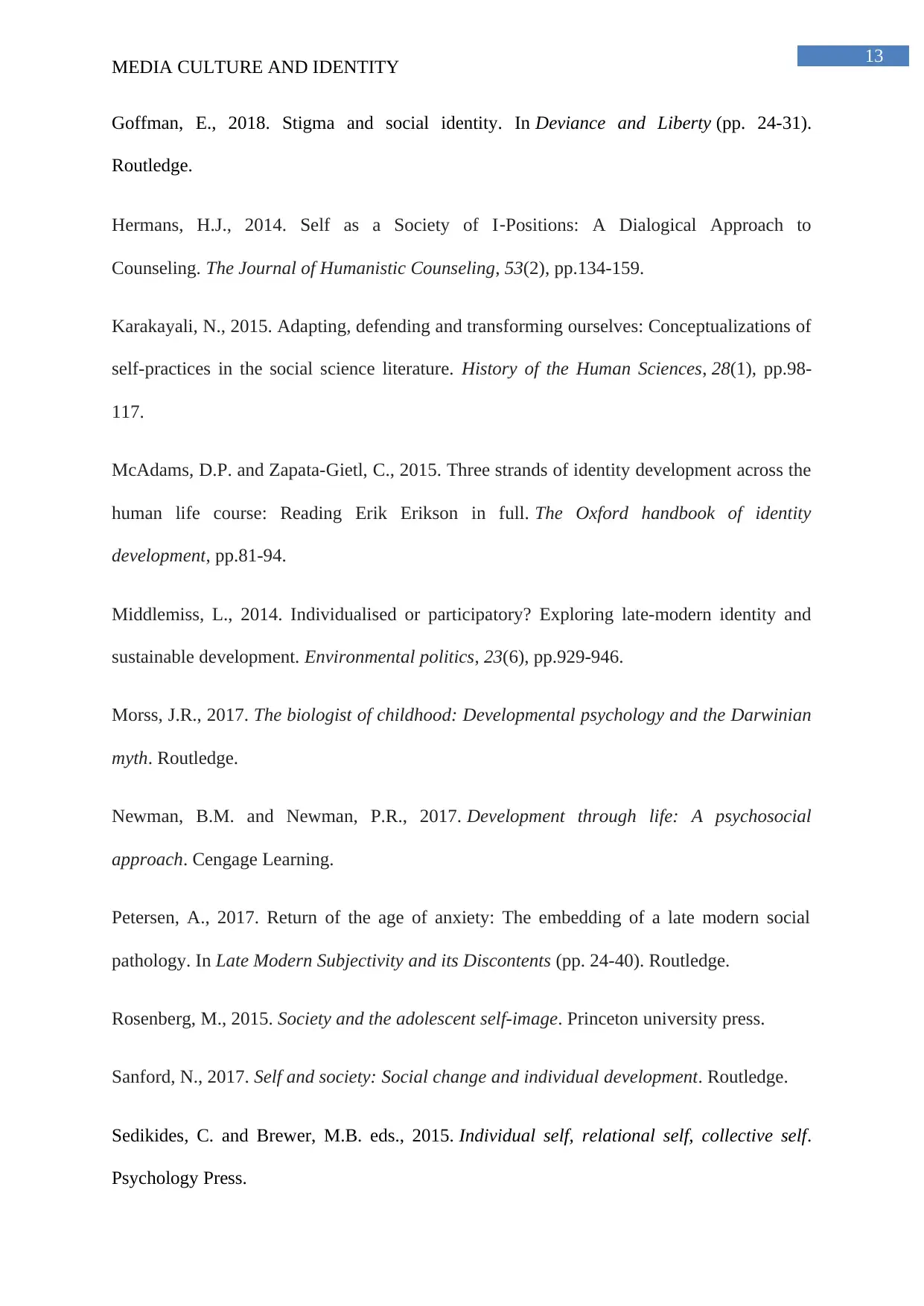
13
MEDIA CULTURE AND IDENTITY
Goffman, E., 2018. Stigma and social identity. In Deviance and Liberty (pp. 24-31).
Routledge.
Hermans, H.J., 2014. Self as a Society of I‐Positions: A Dialogical Approach to
Counseling. The Journal of Humanistic Counseling, 53(2), pp.134-159.
Karakayali, N., 2015. Adapting, defending and transforming ourselves: Conceptualizations of
self-practices in the social science literature. History of the Human Sciences, 28(1), pp.98-
117.
McAdams, D.P. and Zapata-Gietl, C., 2015. Three strands of identity development across the
human life course: Reading Erik Erikson in full. The Oxford handbook of identity
development, pp.81-94.
Middlemiss, L., 2014. Individualised or participatory? Exploring late-modern identity and
sustainable development. Environmental politics, 23(6), pp.929-946.
Morss, J.R., 2017. The biologist of childhood: Developmental psychology and the Darwinian
myth. Routledge.
Newman, B.M. and Newman, P.R., 2017. Development through life: A psychosocial
approach. Cengage Learning.
Petersen, A., 2017. Return of the age of anxiety: The embedding of a late modern social
pathology. In Late Modern Subjectivity and its Discontents (pp. 24-40). Routledge.
Rosenberg, M., 2015. Society and the adolescent self-image. Princeton university press.
Sanford, N., 2017. Self and society: Social change and individual development. Routledge.
Sedikides, C. and Brewer, M.B. eds., 2015. Individual self, relational self, collective self.
Psychology Press.
MEDIA CULTURE AND IDENTITY
Goffman, E., 2018. Stigma and social identity. In Deviance and Liberty (pp. 24-31).
Routledge.
Hermans, H.J., 2014. Self as a Society of I‐Positions: A Dialogical Approach to
Counseling. The Journal of Humanistic Counseling, 53(2), pp.134-159.
Karakayali, N., 2015. Adapting, defending and transforming ourselves: Conceptualizations of
self-practices in the social science literature. History of the Human Sciences, 28(1), pp.98-
117.
McAdams, D.P. and Zapata-Gietl, C., 2015. Three strands of identity development across the
human life course: Reading Erik Erikson in full. The Oxford handbook of identity
development, pp.81-94.
Middlemiss, L., 2014. Individualised or participatory? Exploring late-modern identity and
sustainable development. Environmental politics, 23(6), pp.929-946.
Morss, J.R., 2017. The biologist of childhood: Developmental psychology and the Darwinian
myth. Routledge.
Newman, B.M. and Newman, P.R., 2017. Development through life: A psychosocial
approach. Cengage Learning.
Petersen, A., 2017. Return of the age of anxiety: The embedding of a late modern social
pathology. In Late Modern Subjectivity and its Discontents (pp. 24-40). Routledge.
Rosenberg, M., 2015. Society and the adolescent self-image. Princeton university press.
Sanford, N., 2017. Self and society: Social change and individual development. Routledge.
Sedikides, C. and Brewer, M.B. eds., 2015. Individual self, relational self, collective self.
Psychology Press.
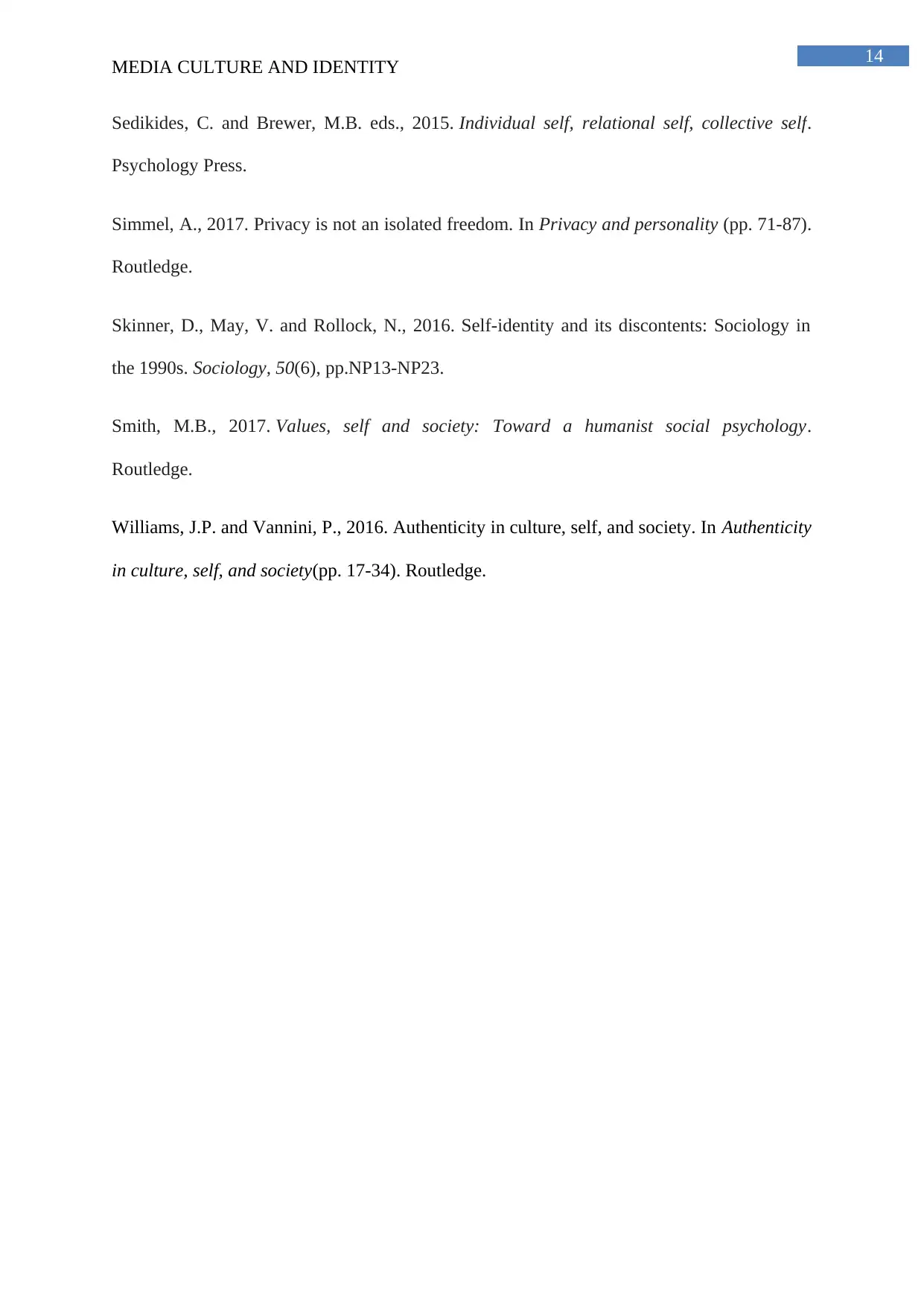
14
MEDIA CULTURE AND IDENTITY
Sedikides, C. and Brewer, M.B. eds., 2015. Individual self, relational self, collective self.
Psychology Press.
Simmel, A., 2017. Privacy is not an isolated freedom. In Privacy and personality (pp. 71-87).
Routledge.
Skinner, D., May, V. and Rollock, N., 2016. Self-identity and its discontents: Sociology in
the 1990s. Sociology, 50(6), pp.NP13-NP23.
Smith, M.B., 2017. Values, self and society: Toward a humanist social psychology.
Routledge.
Williams, J.P. and Vannini, P., 2016. Authenticity in culture, self, and society. In Authenticity
in culture, self, and society(pp. 17-34). Routledge.
MEDIA CULTURE AND IDENTITY
Sedikides, C. and Brewer, M.B. eds., 2015. Individual self, relational self, collective self.
Psychology Press.
Simmel, A., 2017. Privacy is not an isolated freedom. In Privacy and personality (pp. 71-87).
Routledge.
Skinner, D., May, V. and Rollock, N., 2016. Self-identity and its discontents: Sociology in
the 1990s. Sociology, 50(6), pp.NP13-NP23.
Smith, M.B., 2017. Values, self and society: Toward a humanist social psychology.
Routledge.
Williams, J.P. and Vannini, P., 2016. Authenticity in culture, self, and society. In Authenticity
in culture, self, and society(pp. 17-34). Routledge.

15
MEDIA CULTURE AND IDENTITY
MEDIA CULTURE AND IDENTITY
1 out of 16
Related Documents
Your All-in-One AI-Powered Toolkit for Academic Success.
+13062052269
info@desklib.com
Available 24*7 on WhatsApp / Email
![[object Object]](/_next/static/media/star-bottom.7253800d.svg)
Unlock your academic potential
© 2024 | Zucol Services PVT LTD | All rights reserved.




